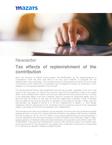
Tax effects of replenishment of the contribution
The aforementioned Official Letter establishes that such figure seeks, regardless of the size of the losses of the fiscal year, "to recover the economic value of the contributions made to the capital stock". It also indicates that in order to carry out such replenishment, there should not be an increase in the subscribed capital, much less a statutory reform to increase the authorized capital, since "it does not imply the creation of new units into which the capital stock is divided". Finally, it indicates that this replenishment may be voluntary or mandatory if the bylaws so provide, in which case the administrators are obliged to enforce it. In his text, 'Replacement of capital (...)', Raúl Vargas establishes that the replacement of the contribution cannot exceed the amount of the subscribed capital, since doing so would turn this operation into a capitalization.
Two examples show when the contribution can be replaced. The first is when the contributed movable property perishes or is lost; if it is a certain body, the contributor may replace it with money or withdraw from the company (C. de Co. Art. 127), while, if it is a property determined by its kind and quantity, it must be replaced by the same type of property. Another example is the contribution made in crypto-assets (operation considered valid by the Superintendence of Corporations since Official Letter 100-237890/2020). If the same are contributed for a value of 100, but due to a drop in the market, these end up being worth 25, then the partners may replace their contribution in the amount corresponding to 75, without such operation implying a capital increase.
Now, the purpose of this column is to determine what tax treatment should be given to the replacement of the contribution. Clearly, such operation could not be framed within the corporate reorganizations established in article 319 and following of the Tax Statute, since it is not a contribution operation where -in exchange- new shares are released. In the same sense, since the contributor does not receive anything in exchange for his contribution, it cannot be stated that he has an income from the contribution.
It remains then to analyze whether the replacement of the contribution generates taxable income for the receiving company. For this purpose, the definition of income in the annex of Decree 2270 of 2019 must be analyzed, which establishes that "the increases in economic benefits, produced throughout the accounting period, in the form of entries or increases in the value of assets, or as decreases in liabilities, which result in increases in equity, and are not related to the contributions of the owners" will constitute income. Since this increase in profits comes from a contribution from the owners and does not generate an increase in equity (but rather a replacement of the same), it cannot be considered as income in the strict sense of the word. Since there is no accounting income, it cannot be considered as realized for tax purposes, for which reason the contribution replacement operation should not be taxed in the receiving company.


